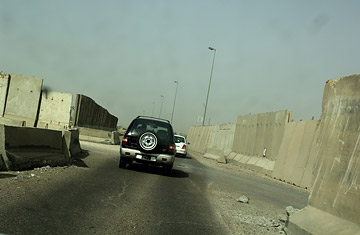
The road from Baghdad International Airport.
Some people read tea-leaves; I read aircraft. Looking out from the passenger lounge in Amman, Jordan, I see that we'll be flying into Baghdad on an Airbus A320. For an old Iraq hand, that's a sign that Iraqi capital is safer than it has been in years.
The A320 is a big plane — 130 passengers — too big to execute the infamous "Baghdad welcome," that heart-stopping corkscrew dive that characterized all my previous landings. The maneuver was designed to evade any terrorist attack by surface-to-air missiles, and executed to petrifying perfection by former South African air force pilots flying smaller, more nimble Fokker F-28 aircraft. Now Royal Jordanian Airways is willing to risk using the larger, more cumbersome (and more expensive) A320, it can only mean that the likelihood of a SAM attack has greatly diminished. Reassured, I actually sleep through most of the 75-minute flight, waking in time to enjoy my first "normal" descent into Baghdad.
It has been six months since my last visit, the longest I have been away from Iraq in the past 5 years. When last I was here, the U.S. military's "surge" was at its halfway point, and it was too early to tell if it was having any real impact. Since then, I've been following the statistics of hope — the declining frequency of U.S. and Iraqi casualties, the reduced rate of insurgent attacks and suicide bombings. By the numbers, the surge has been a success. But I'm suspicious of statistics.
The first test — the landing — has gone well. The second will go even better: the ride home from the airport, once known as the Highway of Death because of the high incidence of insurgent attacks on commuters and military convoys, is remarkably stress-free. The Iraqi colleagues who have come to collect me laugh and joke as we drive; there's none of the nervous anxiety of previous trips. There are some Iraqi security forces along the road, but I see no American patrols.
Can this be for real? My colleagues warn me against irrational exuberance. Some things have improved since the surge, they say, but many of Baghdad's dangers remain. Since I was here last, one of our Iraqi staffers has had to flee the country after receiving death threats. Two others have moved their families out, into Jordan and Syria, for their protection. Sami, who is driving me from the airport, tells me that Iraqis who are going to the airport still carry giant suitcases, stuffed to bursting point, a telltale sign they are not planning to return. My flight in had more foreigners (mostly contractors and private security men) than Iraqis — and there were very few large suitcases on the carousel.
Driving into the city, I see one of the many new concrete blast walls that have gone up since my last departure: there seeem to be miles and miles of these walls, circling off some of the most violent neighborhoods, like Dora and Amiriyah. They keep sectarian militias from marauding freely through the city, as they did before the surge. In many places, artists have painted huge murals on the walls, mostly scenes from Iraq's history, stretching back to the time of Hammurabi. The purpose is to make the walls seem less oppressive, but it also has another, unintended effect — the murals give the walls an air of permanence.
In the evening, I visit the main commercial district: the oft-bombed Karrada. It straddles two broad avenues — Karrada In and Karrada Out — lined with shops selling everything from color TVs and furniture to vegetables and fruit. The two avenues are separated in some places by a single city block, and one is easily confused for the other. Now they seem worlds apart. Karrada In is buzzing: several new kebab restaurants have sprung up, and many shops have expanded. Karrada Out is the opposite, dark and empty, with most of the shops shuttered. Why? One explanation is that many of the businessmen have fled to Jordan and Syria. Another is that the Mahdi Army, Moqtada al-Sadr's Shi'ite militia, has taken charge of large portions of Karrada, extorting prrotection money from shopkeepers.
In many ways Karrada perfectly captures the new Baghdad: hope on one street and gloom on another. This is an improvement from a year ago, when often there seemed no hope at all — but much of the city remains enveloped in darkness, literal and metaphorical, that can't be hidden behind painted walls.
